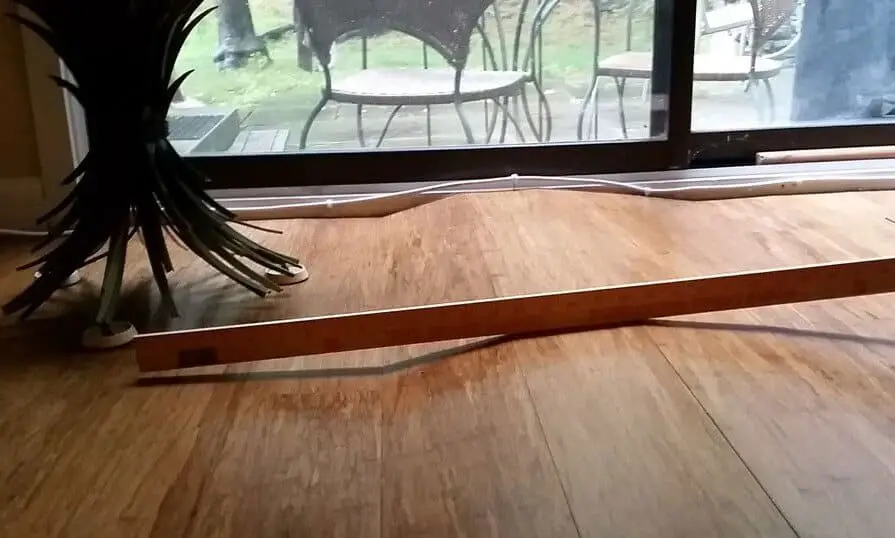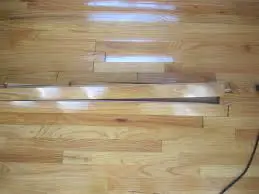If you are looking for how to fix wood floor buckling, it means your wood must have been exposed to moisture for a long period. Moisture is never friendly to wood; it causes wood to swell, twist, warp and buckle.
When you notice that your wood floorboards lift up at their edges, the floorboards have an unsightly hump in the middle or your floorboards appear like they are lifting from the subfloor, your wood floor is buckling. Don’t panic, in this article, we will talk about how to fix wood floor buckling.
Equipment Needed
Table of Contents
- Circular saw
- Hammer
- Chisel
- Replacement plank
- Drill with a spade bit
- Screwdriver or pry bar
- Measuring tape
- Stain
- Paintbrush
- Humidifier or dehumidifier
- Floor finish
- Fine-grit sandpaper
- Scrap lumber
How To Fix Wood Floor Buckling
Here is a step-by-step guide on how to fix wood floor buckling when it has passed the stage of repairing:
- Start by making sure that both the subfloor and the wood flooring are fully dry. Make use of a dehumidifier or humidifier to do this .if you don’t dry the wood, the new wood you want to fix will absorb moisture and buckle again.
- Remove the plank. Do this carefully, so that you won’t damage other planks. An appropriate way to do this is to drill a hole on each end of the damaged plank with the use of a spade bit.
- Cut a small groove from one hole to the next, using the circular saw. Cut only the depth of the plank. The groove will make the plank weak, and make you pry the plank out from the center easily.
- Use a heavy-duty screwdriver or pry bar to pry out damaged planks. Do this with care, so that you won’t damage the tongue-and-groove of adjacent planks. Do not attempt pulling out the nails attached to the board when you are prying out the board. You will do this later on.
- Carefully tap along the tongue to break it off and separate it from the adjacent plank, and then remove all planks that are damaged.
- You can now remove any remaining nails or use a hammer to drive the nails into the subfloor. Clean up the subfloor and get rid of debris.
- Measure and cut fresh planks. Make use of a chisel and hammer to remove the bottom part of the groove along the plank.
- Place the new plank in a way that the tongue faces up. Fix the plank into place and make sure it aligns with the surface of the floor.
- Drive the nails into the wood at an angle that is one foot apart along the edge of the plank. Ensure that the head of the nails is beneath the plank’s surface.
- Fill up the nail holes with wood putty. Smoothen the putty and allow it to dry.
- If the wood is unfinished, use fine-grit sandpaper to smoothen the new boards.
- Stain and finish the new boards. Ensure that the stain matches with the stain of the present flooring, to maintain uniformity. Give the stain and finish time to dry and then move on to using and maintaining your wood floor.
Signs Of Wood Floor Buckling
- Crowning in the center of a board.
- Cupped edges on the side of the board.
- Separations or cracks in between the board.
- Horizontal curvature on the wood floor.
- Lifting is seen where the board pulls up from the subfloor.
Why Is My Hardwood Floor Buckling?
Below are the most common reasons for wood floor buckling:
Humidity
Fluctuation in humidity levels can affect hardwood floors. While humidity level rises in summer, it is very low in the winter. Changes in humidity levels are observed throughout the day, and it has an impact on hardwood floors.
High humidity levels feature too much moisture content, creating pressure between the planks and causing the hardwood floor to swell. Extended periods of high humidity level result in buckling of hardwood floors.
Because of this, the National Wood Floor Association [NWFA] recommended that humidity levels should be kept between 30% and 50% to ensure the proper maintenance of hardwood floors. You can adhere to this recommendation by using air conditioners and humidifiers to keep the levels in check.
Floods And Leaks
Moisture is the greatest enemy of hardwood floors. Buckling of hardwood flooring occurs when the floor has been exposed to moisture for a prolonged period. Moisture can get to your hardwood floor due to subfloor moisture buildup, flooding drainage issues, or pipe leakage.
Although hardwood from trees is cut and shaped into a flooring material, it still exhibits its natural character. Wood is hygroscopic in nature; it reacts to changes in the moisture content of its immediate environment. When wood gets in contact with moisture and the moisture is unable to spread laterally, the wood expands and buckling occurs.
Therefore, the first step to take in fixing wood floor buckling is to know the source of moisture and doing the needful.
Not Making The Wood Go Through Acclimation
Acclimation involves adjusting the moisture content of wood flooring to the environment where such wood is expected to perform.
Most manufacturers advise that wood should be acclimated to the new environment it will be used in. this is because wood is generally sourced from various regions; so, after it is shipped and stored in various locations, it is recommended that the wood should be given some time to acclimatize with its new environment or space.
When you do not follow this recommendation, your hardwood floor will start showing signs of distortion. Because of the difference in moisture content, the wood will absorb moisture and swell up, and then end up buckling.
Therefore, you should not rush to install your hardwood floor without allowing it to acclimate with the new environment. It is better to painstakingly go through this step than having to deal with the consequences later on.
Installing Hardwood Floor Incorrectly
Another reason for buckling in hardwood flooring is incorrect installation. Incorrect installation can occur in many scenarios:
- Not attaching the hardwood floor properly to the subfloor,
- Not preparing the surface well before installation,
- Having uneven surface beneath,
- Insufficient or inadequate nailing and
- Use of low-quality products for installation
If the hardwood floor is not given enough space to expand, it will lift itself from the subfloor and look buckled as a result of moisture retention.
Therefore, it is important to hire hardwood floor experts to install your hardwood floor, to ensure that the right methods and tools are used. If they are tongue and groove flooring, make sure they are fitted correctly.
Not Maintaining And Caring For The Floor
Hardwood floors must be properly cared for, to ensure its longevity and maintenance of beauty. Some people use soap and water to mop their hardwood floors. This is wrong because the hardwood floor will absorb moisture and then buckling will occur.
In place of soap and water, make use of a microfiber mop to clean your hardwood floor. Unlike brooms, microfiber is designed to trap dust and dirt.
Not cleaning spills immediately can damage your hardwood floor. Clean spills immediately you notice them so that you can reduce the rate at which your hardwood floor absorbs moisture. You can use floor coverings appropriate for wood floors like rugs and mats to protect your hardwood floor and minimize damage.
Repairing Minor Buckling Of Wood Floor
Suck up excess moisture using a dry cloth or towel. Clean the area with an appropriate disinfectant. This is needed because excess moisture can be trapped in debris and dirt. Proceed to dry and vacuum the area properly.
You can make the drying process fast by turning on an electric fan. After that, put a dehumidifier in position for a minimum of 24 hours. The board will then return to normal if the buckling is just a minor one. However, if the boards are still showing signs of damage and buckling, they have to be replaced.
Conclusion
At this point, I’m sure you know how to fix wood floor buckling. Fixing wood floor buckling depends on the extent of the damage. In most cases, buckled wood floors are not repairable and end up being replaced. So it is of utmost importance that you maintain your hardwood floors’ beauty and longevity by cleaning it regularly and removing spillage immediately they occur.


